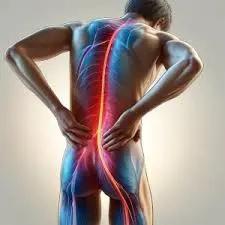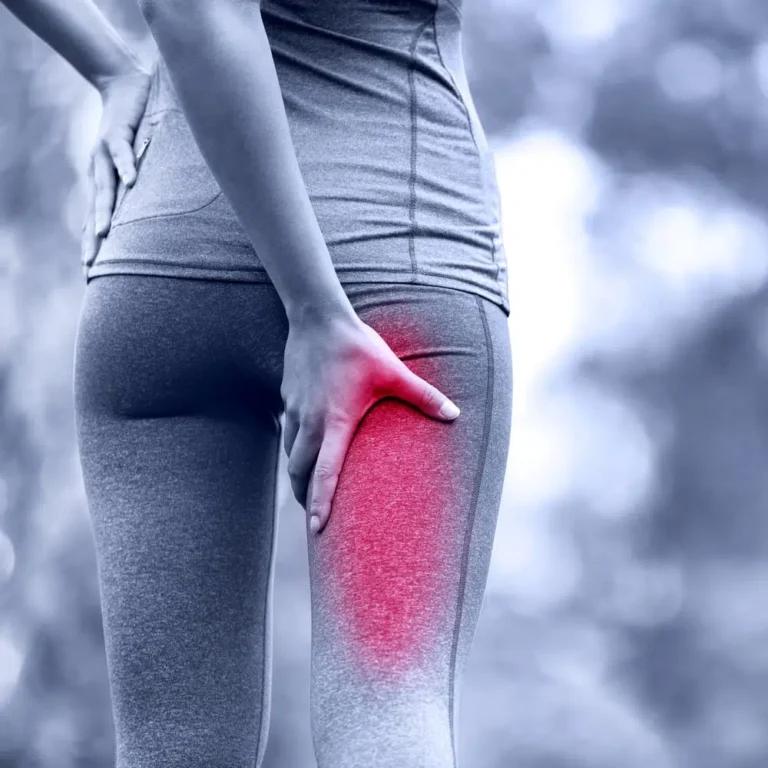If you have been diagnosed with sacroiliac joint pain you have a number of different treatment options. Healthcare professionals normally start with nonsurgical treatments, such as medications, physical therapy, or steroid injections. In some cases non-surgical treatments such as SI joint fusion will be considered. Lets take a deeper look into what sacroiliac joint pain is and how it can be treated.
📝 What is sacroiliac (SI) joint pain?
SI joint pain is also known by a number of different terms:
- Sacroiliitis
- SI joint pain
- SI joint strain
- SI joint dysfunction
- SI joint disease
The SI joint is essentially where our pelvis meets our spine (at the sacrum bone). The two dimples you can see on the lower back just above your butt cheeks – that’s where we are talking about. The SI joint absorbs the pressure between the upper body and lower body when moving to reduce pressure felt in the lower spine. It is heavily reinforced by several very strong ligaments and movement at this joint is minimal as it is a stable joint that moves very little. However some conditions cause more movement of this joint.
🔔 Signs of SI joint pain
- You have low back pain on one side of your low back
- The pain gets worse or sharp when you stand on one leg or walk upstairs
- The pain is aggravated by trying to put on pants and socks while standing
- The pain sometimes radiates to your knee but not below
- The severity of the pain quickly reduces when you stop the aggravating activity
😷 Symptoms of SI joint pain
The most common symptoms for patients are:
- Lower back pain
- Lower back numbness, tingling and weakness
- Pelvis/buttock pain
- Hip/groin pain
- Feeling of leg instability (buckling, giving away)
- Disturbed sleep pattern
- Disturbed sitting patterns (unable to sit for long periods)
- Sciatica-like pain in the back of thighs and buttocks
- Avoiding sitting cross legged, keeping legs parallel
🏥 Common causes of sacroiliac joint dysfunction
Pregnancy
During pregnancy the body is shifting and changing to accommodate for the growing belly. This adjustment can involve movement of the pelvis forward or squeezing of the glutes and pressing the hips forward. All of these changes create compression on the backside, between the sacrum and tailbone, which eventually leads to inflammation which radiates at the lower back, hip or butt. It can occur at any point during pregnancy, but most women feel symptoms by mid way of their pregnancy.
Arthritis
Ankylosing spondylitis is arthritis that affects the joints in your spine. It can cause some of the bones in the spine to fuse. This fusing makes the spine less flexible and can result in a hunched posture. If ribs are affected it can be difficult to breathe deeply.
Degenerative arthritis (osteoarthritis) occurs from the bones rubbing against each other when they become damaged or worn away. It is linked with aging, affecting the SI joint, spine, and other joints throughout the body. It can cause loss of disc height, bone changes and narrowed nerve root spaces, leading to pain and discomfort.
Inflammatory disorders
Other health conditions that cause inflammation can cause sacroiliitis too, including:
- Crohn’s disease
- Ulcerative colitis
- Reactive arthritis (Reiter’s syndrome)
- Behçet’s disease
Other causes
- Falls or car accident
- Overuse or repeated stress on joint
- Gait issues
📝 Diagnosis
Diagnosis typically involves a combination of a physical examination, medical history review, checking range of motion and imaging tests such as x-rays, CT scans or MRI scans. Blood tests may also be carried out to rule out other possible causes of joint inflammation.
A diagnostic sacroiliac joint injection may be performed to confirm the cause of pain (often used for treatment too). The SI joint is injected with a local anaesthetic and corticosteroid medication. The injection is given using X-ray fluoroscopy to ensure accurate needle placement in the SI joint. Before and after injection pain levels are monitored and continued for over a week. If the pain level reduces by more than 75%, that is confirmation that the sacroiliac joint is involved in the pain. If the pain level does not change after the injection, it is unlikely that the SI joint is the cause of low back pain.
🏥 Treatment
Pain medication
The first treatment intervention is short term, usually involving over the counter meds such as non-steroidal anti-inflammatory drugs (NSAIDS) like ibuprofen plus stretching exercises. If these don’t provide enough pain management, a health care provider might prescribe a stronger pain relief, depending on the cause of your SI joint pain. Some other medications include:
- Muscle relaxants
- Biologic medicines
- Disease-modifying antirheumatic drugs
Sacroiliac joint injection
An injection into the sacroiliac joint contains a local anaesthetic paired with a steroid to reduce pain and target inflammation in the area. The purpose of the local anaesthetic is to target the source of pain in the joint and the role of the steroid is focused on inflammation reduction.
Physiotherapy
Physiotherapy can play a significant role in managing sacroiliitis:
- Manual therapy: Hands on techniques like joint mobilisation and manipulations can help improve joint mobility and reduce pain
- Exercise plan: Specific exercises are recommended to target the muscles surrounding the sacroiliac joint to improve the mechanics of the lumbar spine, pelvis, and hips. Strengthening exercises help stabilise the joint and improve its function while stretching exercises maintain or restore joint mobility
- Posture correction: On physical exam and observation, improving posture may be suggested to relieve stress on the sacroiliac joints
Surgical and other treatments
When all the above treatments fail, surgery may be offered. These type of procedures can help improve chronic pain
- Sacroiliac joint fusion surgery
- Radiofrequency ablation – this procedure disables nerve fibres that are carrying the pain signal through the spinal cord to the brain
💡 Tips for managing sacroiliac pain and strengthening the sacroiliac joints
- Log roll in and out of bed instead of moving one leg at a time
- Sleep with a pillow between your knees
- Strengthen glutes and core
- Keep your knees together while getting in and out of the car
- Sit down to put on your socks, pants and shoes
- Avoid weighted asymmetrical leg movements (lunges, split squats)
- Avoid long periods of sitting and lying in the same position
- Low-impact exercises (yoga)
📝 Conclusion
There are number of different treatments for sacroiliac joint pain. These include nonsteroidal anti-inflammatory drugs, physical therapy exercises and corticosteroid injections. If SI joint pain is a result of inflammatory arthritis, then drugs prescribed to stop the disease from progressing are also needed. A comprehensive treatment plan is key to relieving SI joint symptoms. It is important to contact your healthcare provider if you have any of the following symptoms:
- Weakness or numbness in your legs
- Have problems controlling your bowel or bladder
- Sudden increase in pain or discomfort
- Slower than expected healing
- A high temperature
- Sudden increase in pain in your other joints
- Pain in your eyes when passing urine
Sources
- Sacroiliac joint injections to treat pain – Overview – Guy’s and St Thomas’ NHS Foundation Trust
- Sacroiliitis: Causes, Symptoms & Treatment Options
- Sacroiliitis – Symptoms and causes – Mayo Clinic
Medical Disclaimer
NowPatient has taken all reasonable steps to ensure that all material is factually accurate, complete, and current. However, the knowledge and experience of a qualified healthcare professional should always be sought after instead of using the information on this page. Before taking any drug, you should always speak to your doctor or another qualified healthcare provider.
The information provided here about medications is subject to change and is not meant to include all uses, precautions, warnings, directions, drug interactions, allergic reactions, or negative effects. The absence of warnings or other information for a particular medication does not imply that the medication or medication combination is appropriate for all patients or for all possible purposes.








